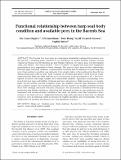Files in this item
Functional relationship between harp seal body condition and available prey in the Barents Sea
Item metadata
| dc.contributor.author | Oigard, Tor Arne | |
| dc.contributor.author | Lindstrom, Ulf | |
| dc.contributor.author | Haug, Tore | |
| dc.contributor.author | Tormod Nilssen, Kjell | |
| dc.contributor.author | Smout, Sophie Caroline | |
| dc.date.accessioned | 2018-10-12T16:30:06Z | |
| dc.date.available | 2018-10-12T16:30:06Z | |
| dc.date.issued | 2013 | |
| dc.identifier | 34761598 | |
| dc.identifier | ed4a19a4-777b-4658-af1c-d9c85590ff5e | |
| dc.identifier | 84879329181 | |
| dc.identifier.citation | Oigard , T A , Lindstrom , U , Haug , T , Tormod Nilssen , K & Smout , S C 2013 , ' Functional relationship between harp seal body condition and available prey in the Barents Sea ' , Marine Ecology Progress Series , vol. 484 , pp. 287-301 . https://doi.org/10.3354/meps10272 | en |
| dc.identifier.issn | 0171-8630 | |
| dc.identifier.uri | https://hdl.handle.net/10023/16208 | |
| dc.description.abstract | The Barents Sea ecosystem has undergone substantial fluctuations over the past 40 years including large variations in the abundance of capelin Mallotus villosus, herring Clupea harrengus, krill Thysanoessa sp. and Meganyctiphanes norvegica and polar cod Boreogadus saida. There is evidence to suggest that harp seals Pagophilus groenlandicus have responded to these changes. The current study analysed the relationship between harp seal body condition, environmental variables, and the biomass of major harp seal prey. Harp seal body condition was estimated from samples taken in the South-Eastern Barents Sea during spring in 1992-2011. Body condition of juveniles and adults varied between years, increasing from 1992 until 2001 and later decreasing, with lowest condition in 2011. We investigated covariates that might explain such inter-annual variation. Significant relationships were found between harp seal blubber thickness and prey abundance. High abundances of capelin, polar cod and atlantic cod Gadus morhua had a negative impact on condition, whereas high abundance of krill had a positive impact. Environmental covariates did not improve the models, probably because these are strongly correlated with prey abundance. We also find a strong linear correlation between pup production and blubber thickness, indicating that observed declines in pup production may be associated with changes in body condition of the seals. We conclude that indirect effects in the food web, probably competition between harp seals and their prey for shared resources such as krill, may result in unexpected negative effects of prey abundance on the condition of a top predator with implications for predator breeding success and population dynamics. | |
| dc.format.extent | 498975 | |
| dc.language.iso | eng | |
| dc.relation.ispartof | Marine Ecology Progress Series | en |
| dc.subject | Harp Seal | en |
| dc.subject | GAM | en |
| dc.subject | Prey availability | en |
| dc.subject | Prey quality | en |
| dc.subject | Barents Sea | en |
| dc.subject | Predator prey | en |
| dc.subject | Body condition | en |
| dc.subject | GE Environmental Sciences | en |
| dc.subject | QH301 Biology | en |
| dc.subject.lcc | GE | en |
| dc.subject.lcc | QH301 | en |
| dc.title | Functional relationship between harp seal body condition and available prey in the Barents Sea | en |
| dc.type | Journal article | en |
| dc.contributor.institution | University of St Andrews. School of Biology | en |
| dc.contributor.institution | University of St Andrews. Scottish Oceans Institute | en |
| dc.contributor.institution | University of St Andrews. Centre for Research into Ecological & Environmental Modelling | en |
| dc.contributor.institution | University of St Andrews. Sea Mammal Research Unit | en |
| dc.identifier.doi | 10.3354/meps10272 | |
| dc.description.status | Peer reviewed | en |
This item appears in the following Collection(s)
Items in the St Andrews Research Repository are protected by copyright, with all rights reserved, unless otherwise indicated.

